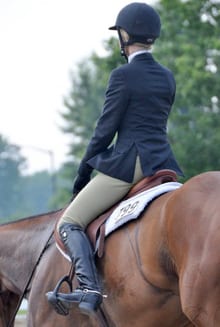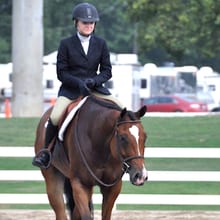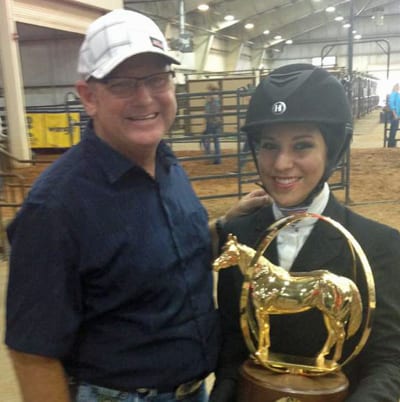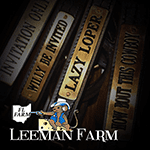When Paige Stopperich walked into the arena to compete in the Hunt Seat Equitation at the 2013 AQHYA World Championship Show, some spectators were looking at her leg, her quiet seat, and connection with her horse. However, others were looking at her choice of headgear. Paige wore an ASTM/SEI approved helmet in a class that has traditionally seen the sleeker lines of velvet hunt caps, yet her performance was evaluated and rewarded without regard to her helmet choice and she left the arena the 2013 AQHYA World Champion in Hunt Seat Equitation.
“I have to give a lot of the credit to my trainer Michael Colvin! He was the one who really pushed me to wear it and be a leader,” says Stopperich.
Statistically, you simply cannot argue about the safety of riding a
horse with a helmet. In 1990, the AHSA (now the USEF) required its
junior riders to have ASTM/SEI Helmets, and finally in 2006 required
adult riders to compete under the same guidelines. They bolstered their
rules in 2012 to include that all riders must wear a helmet when mounted
with some exceptions for dressage and reining while only in competition
for exhibitors over the age of 18.
Starting at the 2014 AQHYA World Championship Show, all youth exhibitors competing in hunt seat classes will be required to wear helmets that are ASTM/SEI approved. With the rule going into effect next August, some youth exhibitors are already wearing safer headgear in flat classes. For the time being, Amateur and open riders will continue to have a choice about their choice of helmets or hunt caps.
At the 2013 Amateur AQHA World Show, there were several exhibitors showing approved helmets in both the hunt seat equitation and hunter under saddle who made the finals and top ten placings.
AQHA Professional Horsewoman Lainie DeBoer has been a proponent for approved helmet wearing for a long time. Several of DeBoer’s friends have had seemingly simple accidents, yet sustained traumatic brain injuries, so she sees this change as truly protecting our youth exhibitors rather than a trend. “I am just so proud of the people that stepped up and wore their helmets this year. I would like to not see it be a trend, but more of a smart life choice. You are decreasing your odds of being hurt on a horse significantly every time you ride with an approved helmet,” said DeBoer.
 DeBoer also coached helmet wearer Ashley Beim to a 2013 AQHA World Championship title in Amateur Equitation who took the title the year before as well. Ashley wore a hunt cap in 2012 and an approved helmet in 2013 with the same results…World Champion.
DeBoer also coached helmet wearer Ashley Beim to a 2013 AQHA World Championship title in Amateur Equitation who took the title the year before as well. Ashley wore a hunt cap in 2012 and an approved helmet in 2013 with the same results…World Champion.
Amateur exhibitor Morgan Parisek wore a One K Defender Air Suede helmet in both hunt seat equitation and hunter under saddle this year at the AQHA Bank of America Amateur World Championship Show and made the finals in the equitation. Beyond feeling safer, Morgan was also worried about how the judges would react.
“At first, I was worried I would get overlooked, because I was wearing a helmet as there have been times in the past it has seemed that way. I was really glad the judges seemed to look past what kind of headgear was on the rider’s head and focused more on the quality of rider that was in front of them,” said Parisek.
Ariel Herrin took home a bronze trophy from Oklahoma City during the Amateur World Championship Show in hunt seat equitation, and she was wearing a Charles Owen GR8. The decision was an easy one for Herrin’s team. Her mother, Cathy Herrin, a professional trainer and mother shared the inside scoop. “We discussed which she was going to wear, and I told her to go with whichever one she felt better in.”
Ariel keeps her horse at school where a helmet is required any time you are on a horse, even your own, so she has gotten into the habit of always wearing one. Herrin wore it every time she rode at the World so whether she was schooling the flat or fences–it was on. With all that in mind, she feels the most comfortable in her helmet and decided to go with that. “I think, most of the time anyway, the judges don’t care what is on top of your head, they are most interested in the strength of your riding and the execution of the pattern,” she says.
 Hunter under saddle and equitation exhibitor Kelley Mundrick prefers the sleeker style, but understands it doesn’t outweigh safety. “I don’t necessarily like the look and all the material, but safety is by far more important than vanity. There are many people who’ve learned the hard way and had their life changed because of it, so when it is such a simple step and way to be safe, why not?” says Mundrick.
Hunter under saddle and equitation exhibitor Kelley Mundrick prefers the sleeker style, but understands it doesn’t outweigh safety. “I don’t necessarily like the look and all the material, but safety is by far more important than vanity. There are many people who’ve learned the hard way and had their life changed because of it, so when it is such a simple step and way to be safe, why not?” says Mundrick.
So, what does this mean for AQHA exhibitors? For youth competitors, be ready to see more and more approved helmets in classes. While the requirement goes into effect at the 2014 Youth World Championship show, exhibitors may want to get used to wearing the new style before the biggest show of the year. Amateur and open riders still have a choice about their choice of helmets or hunt caps, and it seems some adult riders are already making the change for safety and to be an influence in safety for their youth clients.
Stay tuned for a style guide on what types of helmets look best in the show arena. With hundred of styles to choose from, you will definitely want to check back at GoHorseShow.com to find out what options are best in the arena and for safety!









